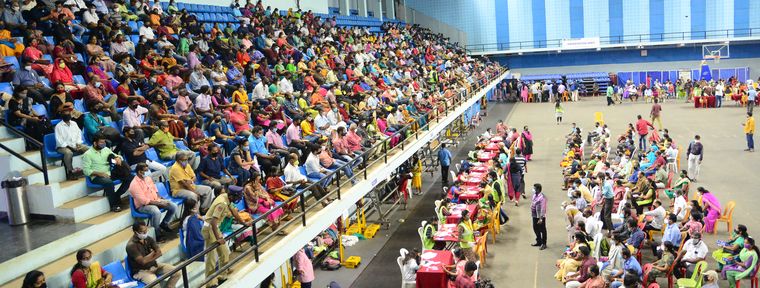SANDHYA S., AN ASHA worker from the Kozhikode district in Kerala, had a tough task at hand for the last three months. Every morning, she had to bring 10 senior citizens to the Covid-19 vaccination centre in her area and had to coordinate with a junior public health nurse to get them vaccinated.
“There were many apprehensions about the vaccines,” recalled Sandhya. “We had to convince the people about the benefits of taking vaccines and then coax them to come to the vaccination centre. It was quite the task. But now I am happy that everybody above 60 in my neighbourhood is vaccinated.”
Divya Santhosh, a nurse at a primary health centre in Kasaragod district, said the challenging task for her was to eliminate vaccine wastage. “Once a vaccine vial is punctured, it has to be used within six hours,” she said. “So, it was important that we had enough beneficiaries present before opening a vial. We ensured this by coordinating with ASHA workers and JPHNs.” According to her, the team would sit together every day and finalise the list of beneficiaries for the next day to ensure that not a single vial was wasted.
Thousands of ASHAs and nurses like Sandhya and Divya were the ones who powered Kerala’s efficient Covid-19 vaccination drive. While over 44 lakh doses were wasted countrywide until April 11, five states—Kerala, Mizoram, West Bengal, Himachal Pradesh and Goa—reported “zero wastage”.
“Our health workers are well adept in handling the vaccination drive,” said Dr Mohammed Asheel, who heads the state social security mission. “The value of every drop of vaccine is very high and we had conveyed this to our vaccinators.”
Up to 10 people can be vaccinated from a 10ml vial. “Most vials contain some extra vaccine. Most of our nurses could use even this extra amount for vaccination [with efficient planning],” said Dr Asheel. He added that the strong cold chain mechanism that the state has also helped in better storage of vaccines.
But there were many hiccups in between because of the local self-government elections and assembly elections. “When the new local self-governments came into existence, there was a lull in the Covid fight,” said Dr Joy Elamon, director general, Kerala Institute of Local Administration. “So, our primary focus after the LSG elections was to create awareness among the new local body representatives about our vaccination drive, and it worked.” According to him, the modernisation that public health institutions have undergone in terms of infrastructure and manpower in the past few years has also played a crucial role.
“The state's public health system is very robust; so is private care,” said Dr B. Ekbal, chairman, Kerala state expert committee on Covid-19 management. “A collaborative effort of both will be crucial in the coming days as Covid-19 cases are going to surge.”


